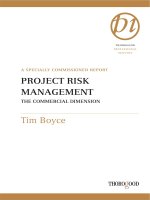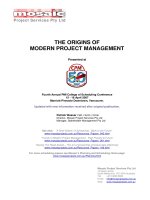Lecture no38 methods of describing project risk
Bạn đang xem bản rút gọn của tài liệu. Xem và tải ngay bản đầy đủ của tài liệu tại đây (1.25 MB, 15 trang )
Methods of Describing Project Risk
Lecture No. 38
Chapter 12
Contemporary Engineering Economics
Copyright © 2016
Contemporary Engineering Economics, 6 th edition
Park
Copyright © 2016 by Pearson Education, Inc.
All Rights Reserved
Chapter Opening Story
• Alcoa has invested $670
million to increase its
production capacity to meet
demand for aluminum to
produce vehicles.
• At Issue:
o What would be the Alcoa’s
financial risk in this expansion
project?
o How should Alcoa factor the
future fluctuation and
uncertainty of automobile
demand into the analysis?
Contemporary Engineering Economics, 6 th edition
Park
Copyright © 2016 by Pearson Education, Inc.
All Rights Reserved
Methods of Describing Project Risk
• Sensitivity analysis: A procedure of identifying the
project variables which, when varied, have the
greatest effect on project acceptability
• Breakeven analysis: A procedure of identifying the
value of a particular project variable that causes
the project to exactly break even
• Scenario analysis: A procedure of comparing a
“base case” to one or more additional scenarios,
such as best and worst cases, to identify the
extreme and most likely project outcomes
Contemporary Engineering Economics, 6 th edition
Park
Copyright © 2016 by Pearson Education, Inc.
All Rights Reserved
Example 12.1: Transmission-Housing Project by
Boston Metal Company
• Given: Financial facts
o Known with great confidence
•
•
•
•
Required investment = $125,000
Project Life = 5 years
Income tax rate = 40%
MARR = 15%
o Unknown but predictable (most likely values)
•
•
•
•
•
Unit variable cost = $15 per unit
Number of units = 2,000 units
Unit Price = $50 per unit
Salvage value = $40,000
Fixed cost = $10,000/yr
• Find: Determine the acceptability of the investment.
Contemporary Engineering Economics, 6 th edition
Park
Copyright © 2016 by Pearson Education, Inc.
All Rights Reserved
Solution
Contemporary Engineering Economics, 6 th edition
Park
Copyright © 2016 by Pearson Education, Inc.
All Rights Reserved
Sensitivity Analysis for Five Key Input
Variables
Deviation
−20% −15%
−10%
−5%
0%
5%
10%
15%
20%
Unit price
$57 $9,999
$20,055
$30,111
$40,169
$50,225
$60,28
1
$70,33
7
$80,39
3
Demand
12,010 19,049
26,088
33,130
40,169
47,208
54,247
61,286
68,325
Variable
cost
52,236 49,219
46,202
43,186
40,169
37,152
34,135
31,118
28,101
Fixed cost
44,191 43,185
42,179
41,175
40,169
39,163
38,157
37,151
36,145
Salvage
value
37,782 38,378
38,974
39,573
40,169
40,765
41,361
41,957
42,553
Variable most sensitive to NPW: Unit price
Variable least sensitive to NPW: Salvage value
Contemporary Engineering Economics, 6 th edition
Park
Copyright © 2016 by Pearson Education, Inc.
All Rights Reserved
Breakeven Analysis
Breakeven analysis is a tool used to
determine when a business will be able to
cover all its expenses and begin to make a
profit from a project.
o Excel using a Goal Seek function
o Analytical approach
Contemporary Engineering Economics, 6 th edition
Park
Copyright © 2016 by Pearson Education, Inc.
All Rights Reserved
Using a Goal Seek Function in Excel
Contemporary Engineering Economics, 6 th edition
Park
Copyright © 2016 by Pearson Education, Inc.
All Rights Reserved
Using a Goal Seek Function in Excel
PW of Inflow: 100.5650X + $44,490
PW of Outflow: 30.1694X + $145,113
NPW = 70.3956X − $100,623
Contemporary Engineering Economics, 6 th edition
Park
Copyright © 2016 by Pearson Education, Inc.
All Rights Reserved
Analytical Approach
PW of cash inflows
PW(15%)Inflow= (PW of after-tax net revenue)
+ (PW of net salvage value)
+ (PW of tax savings from depreciation
= 30X(P/A, 15%, 5) + $37,389(P/F, 15%, 5)
+ $7,145(P/F, 15%,1)
+ $12,245(P/F, 15%, 2)
+ $8,745(P/F, 15%, 3)
+ $6,245(P/F, 15%, 4)
+ $2,230(P/F, 15%,5)
= 30X(P/A, 15%, 5) + $44,490
= 100.5650X + $44,490
PW of cash outflows:
PW(15%)Outflow = (PW of capital expenditure
+ (PW) of after-tax expenses
= $125,000 + (9X+$6,000)(P/A, 15%, 5)
= 30.1694X + $145,113
Contemporary Engineering Economics, 6 th edition
Park
The NPW:
PW (15%) = 100.5650X
+ $44,490
− (30.1694X
+ $145,113)
=70.3956X
−$100,623
Breakeven volume:
PW (15%)= 70.3956X
−$100,623
=0
Xb =1,430 units.
Copyright © 2016 by Pearson Education, Inc.
All Rights Reserved
Scenario Analysis
• Scenario analysis is a process of analyzing
possible future outcomes by considering
alternative possible events (scenarios). The
analysis is designed to improve decisionmaking by allowing more complete
consideration of outcomes and their
implications.
Source: Wikipedia
Contemporary Engineering Economics, 6 th edition
Park
Copyright © 2016 by Pearson Education, Inc.
All Rights Reserved
Example 12.3: Scenario Analysis
Given: Three plausible scenarios assuming
asset of values for key input variables.
Find: Range of NPW
Contemporary Engineering Economics, 6 th edition
Park
Copyright © 2016 by Pearson Education, Inc.
All Rights Reserved
Worst Case Scenario
Contemporary Engineering Economics, 6 th edition
Park
Copyright © 2016 by Pearson Education, Inc.
All Rights Reserved
Best Case Scenario
Contemporary Engineering Economics, 6 th edition
Park
Copyright © 2016 by Pearson Education, Inc.
All Rights Reserved
Summary Outcome
Contemporary Engineering Economics, 6 th edition
Park
Copyright © 2016 by Pearson Education, Inc.
All Rights Reserved









